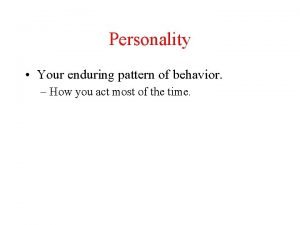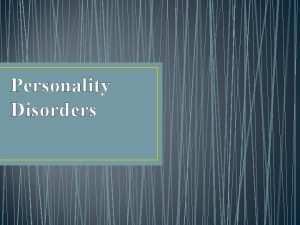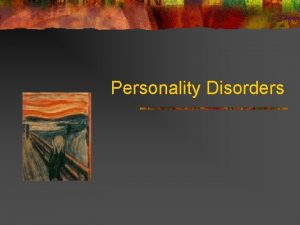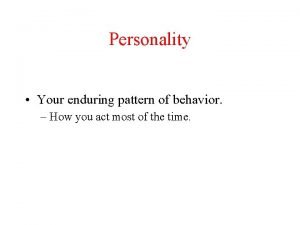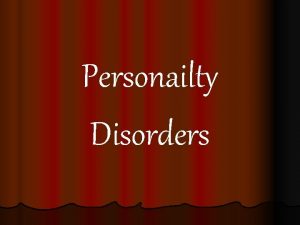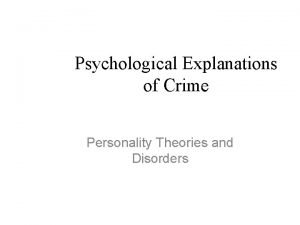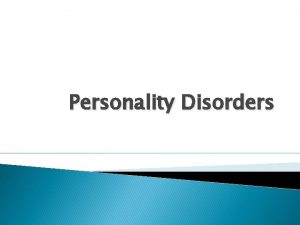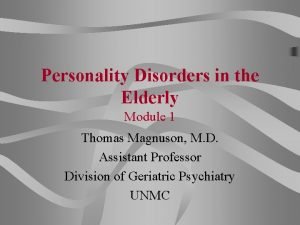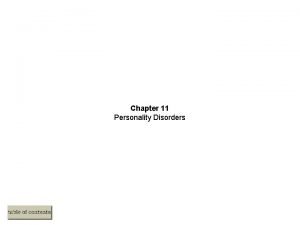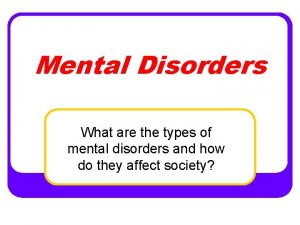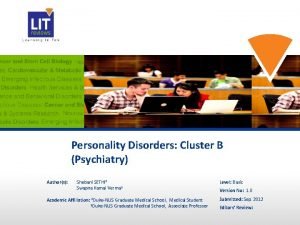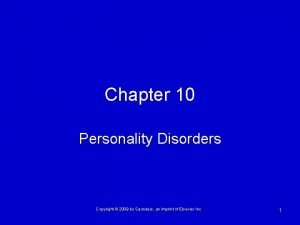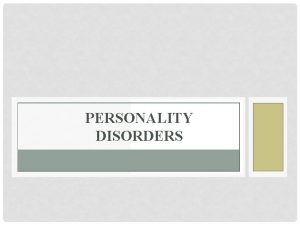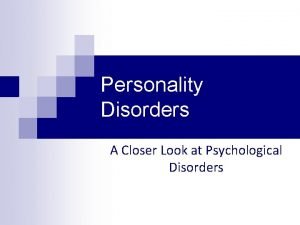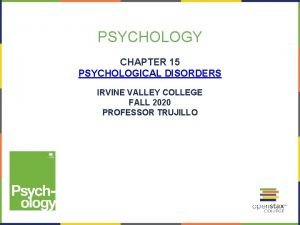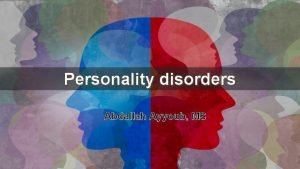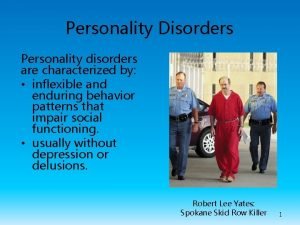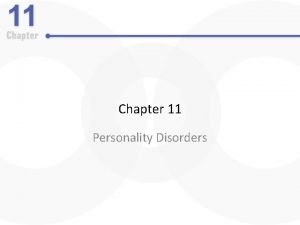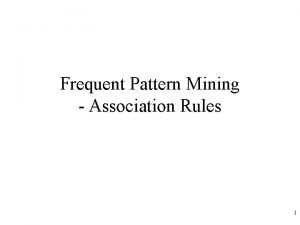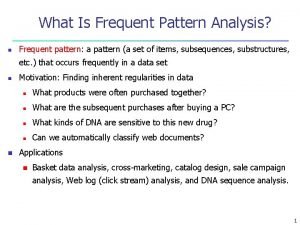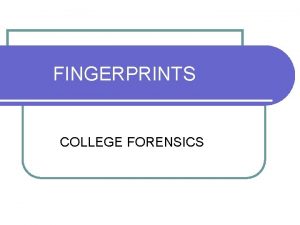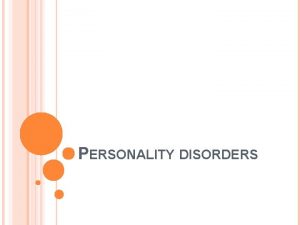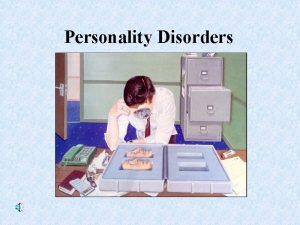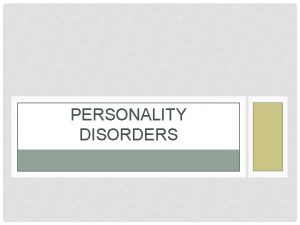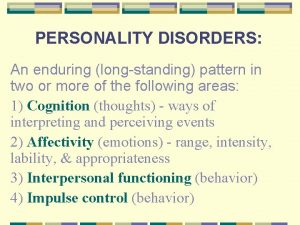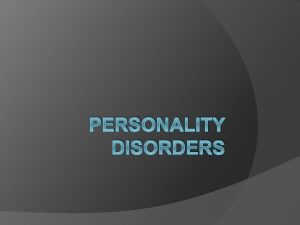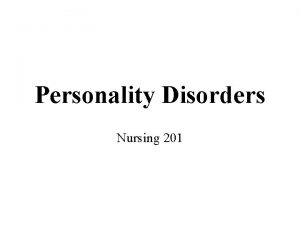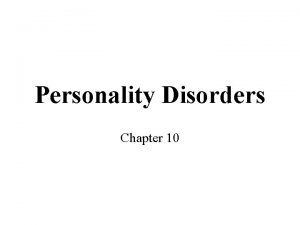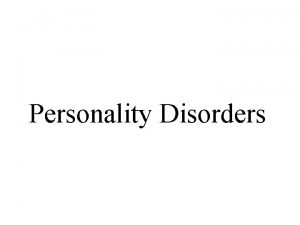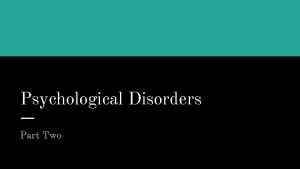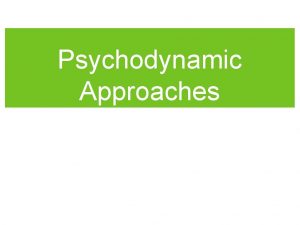Personality Disorders Personality Disorders An enduring pattern of






























- Slides: 30

Personality Disorders

Personality Disorders • An enduring pattern of inner experience and behavior that manifests in two or more of the following: • cognition (i. e. , ways of perceiving and interpreting self and others); Affectivity (i. e. , range, intensity, lability) ; Interpersonal functioning; Impulse control • The enduring pattern is inflexible • It leads to significant distress or impairment in functioning • The pattern is stable and can be traced back to adolescence or early adulthood

Why should you look for personality disorders? • They are common! Prevalence estimated between 6 -13% of the adult population in the United States has a personality disorder!! • Recognizing personality disorders can guide your approach to them • Identifying a personality disorder allows you to assess for comorbities including Axis I disorders and suicide risk Paris. J. 2010 Estimating the prevalence of personality disorders in the community. J personal dis, 24(4): 405 -411

Prevalence • OCPD 2% • Paranoid 2% • Antisocial 1 -4% • Schizoid 1%? • Schizotypical 1% • Avoidant 1 -2% • Histrionic 2% • Borderline 2 -3% • Dependent 0. 5% • Narcissistic. 5 -1% Torgerson, S. 2009 The nature and nurture of personality disorders. Scan J psychol 50: 624 -632

Etiology • Likely multi-factorial like almost all other psychiatric diagnoses. • Genetic and environmental factors such as chaotic home environment and abuse have been implicated in development of maladaptive behavioral patterns.

Genetics of PD cont. • For comparison heritability of normal personality traits is approximately 0. 5 • Molecular genetics studies of PDs indicate that genes linked to neurotransmitter pathways, particularly the serotonergic and dopaminergic systems are involved. Reichborn-Kjennerud T. 2010 Dialogues Clin Neurosci 12(1): 103 -114

Personality Disorder Clusters • Cluster A: suspicious, odd • Paranoid, Schizotypal • Cluster B: dramatic • Antisocial, borderline, histrionic, narcissistic • Cluster C: anxious • Avoidant, dependent, obsessive-compulsive

Paranoid Personality disorder • A pervasive distrust and suspiciousness of others such that their motives are interpreted as malevolent. • Suspects others are exploiting or deceiving him • Preoccupied with unjustified doubts of loyalty • Is reluctant to confide in others because he believes they will use the information against him

Paranoid Personality Disorder cont. • Reads hidden demeanings into benign • • • remarks Persistently bears a grudge Perceives attacks on his character Recurrent suspicions regarding fidelity of spouse or sexual partner

Schizoid Personality Disorder • Pervasive pattern of detachment from social relationships and restricted expression of emotion with 4 or more the following: • Neither desires nor enjoys close relationships • Almost always chooses solitary activities • Little if any interest in sexual experiences with another person • Takes pleasure in few in any activities

• Lacks close friends other than first-degree relatives • Appears indifferent to the praise or criticism of others • Shows emotional coldness or flattened affect

Schizotypal Personality Disorder • A pervasive pattern of social and interpersonal deficits with reduced capacity for close relationships as well as cognitive or perceptual distortions and eccentricities of behavior with 5 or more of the following: • Ideas of reference • Odd beliefs or magical thinking • Unusual perceptual experiences including bodily illusions

• Odd thinking and speech • Suspiciousness or paranoid ideation • Inappropriate or constricted affect • Behavior or appearance that is odd or eccentric • Lack of close friends other than first-degree relatives • Excessive social anxiety that does not diminish with familiarity

Antisocial Personality Disorder • A pervasive pattern of disregard for and violation of the rights of others occurring since the age of 15 years as indicated by 3 or more of the following: • Failure to conform to social norms with respect to lawful behaviors • Deceitfulness and conning others for personal profit or pleasure

• Impulsivity or failure to plan ahead • Irritability or aggressiveness as indicated by • • repeated fights or assaults Reckless disregard for safety of self or others Consistent irresponsibility Lack of remorse There is evidence of Conduct Disorder with onset before age 15

Neuroimaging and psychopathy • Study by Blair found person with psychopathic tendencies showed decreased amygdala and orbitofrontal cortex responses to emotionally provocative stimuli which the author felt was suggestive of difficulties with basic forms of emotional learning and decision making. Blair R. 2010 Neuroimaging of psychopathy and antisocial behavior: a targeted review. Curr Pysch Res Feb; 12(1): 76 -82

Borderline Personality Disorder • Pervasive pattern on instability of interpersonal relationships, self image and affects and marked impulsivity as indicated by 5 or more of the following: • Frantic efforts to avoid abandonment • Unstable and intense interpersonal relationships characterized by alternating between extremes of idealization and devaluation

• Identity disturbance • Impulsivity in at least two areas that are potentially self-damaging • Recurrent suicidal behaviors, gestures or threats or self-mutilating behaviors • Affective instability due to a marked reactivity of mood • Chronic feelings of emptiness • Inappropriate anger • Transient, stress-related paranoia

Histrionic Personality Disorder • Pervasive pattern of excessive emotionality and attention seeking indicated by >5 of the following: • Uncomfortable in situations in which he is not the center of attention • Interaction with others often characterized by inappropriate sexually seductive behavior • Displays rapidly shifting and shallow expression of emotion

• Consistently uses physical appearance to draw attention to self • Has a style of speech that is excessively impressionistic and lacking in detail • Shows self-dramatization and exaggerated emotion • Is suggestible • Considers relationships to be more intimate than they are

Narcissistic Personality Disorder • A pervasive pattern of grandiosity (in fantasy or behavior), need for admiration, lack of empathy as indicated by >5 of the following: • Grandiose sense of self-importance • preoccupied with fantasies of unlimited success, power, brilliance or beauty • Believes he is special and can only be understood or should associate with other special or high status people

• Requires excessive admiration • Has a sense of entitlement • Is interpersonally exploitive • Lacks empathy • Is often envious of others and believes others are envious of him • Shows arrogant, haughty behaviors or attitudes

Avoidant Personality Disorder • A pervasive pattern of social inhibition, feelings of inadequacy and hypersensitivity to negative evaluation as indicated by >4 of the following: • Avoids social occupations that involve significant interpersonal contact • Is unwilling to get involved with people unless certain of being liked • Is preoccupied with being criticized in social situations

• Shows restraint in intimate relationships because of fear of being shamed or ridiculed • Inhibited in new interpersonal situations because of feeling inadequate • Views self as socially inept and unappealing • Is unusually reluctant to take personal risks or engage in any new activities because they may prove embarrassing

Dependent Personality Disorder • A pervasive and excessive need to be taken care of that leads to submissive and clinging behaviors and fears of separation as indicated by >5 of the following: • Has difficulty making everyday decisions without an excessive amount of reassurance • Needs others to assume responsibility for most major areas of his life

• Has difficulty expressing disagreement with others • • • because of fear of loss of approval Difficulty initiating projects on his own because of lack of self confidence Goes to excessive lengths to obtain nurturance and support from others Feels uncomfortable or helpless when alone Urgently seeks another relationship as a source of care and support when a relationship ends Is unrealistically preoccupied with fears of being left to take care of himself

Obsessive-Compulsive Personality Disorder • A pervasive pattern of preoccupation with orderliness, perfectionism and mental and interpersonal control at the expense of flexibility, openness as indicated by >4 of the following: • Preoccupied with details, rules, lists, order or schedules to the extent that the major point of the activity is lost • Shows rigidity and stubbornness

• Perfectionism that interferes with task completion • Excessively devoted to work and productivity to • • the exclusion of leisure activity and friends Over conscientious and inflexible about matters of morals or ethics Is unable to discard worn or worthless objects even those without sentimental value Reluctant to delegate tasks Adopts miserly spending style toward self and others

Treatment • Can reduce symptomatology, improve social and interpersonal functioning, reduce frequency of maladaptive behaviors and decrease hospitalizations. • Always screen for comorbid psych dx • If the personality disorder is ego-syntonic (eg. Antisocial and Narcissistic) it will be hard to engage the patient in treatment

Screening for comorbid disorders • Antisocial PD: Alcohol dependence and depressive disorders • BPD: alcohol and drug dependence, mood disorders, anxiety disorders inc PTSD • Histrionic PD: alcohol dependence, somatization disorder • Avoidant PD: social phobia • Any PD puts pt at higher risk than the gen population for Etoh and drug dep. Trull T et al. 2010 Revised NESARC personality disorder diagnosis: gender, prevalence, and comorbidity with substance dependence disorders. J personal Dis 24(4): 412 -426
 Enduring pattern of behavior
Enduring pattern of behavior Enduring pattern meaning
Enduring pattern meaning Enduring patterns
Enduring patterns Enduring pattern meaning
Enduring pattern meaning Enduring pattern
Enduring pattern Enduring pattern meaning
Enduring pattern meaning Enduring pattern meaning
Enduring pattern meaning Cluster b personality disorder
Cluster b personality disorder Type c personality disorder
Type c personality disorder Cluster b
Cluster b Cluster b personality disorders
Cluster b personality disorders Dramatic personality disorders
Dramatic personality disorders Cluster c personality disorders
Cluster c personality disorders Shebani sethi
Shebani sethi Cluster b personality disorders
Cluster b personality disorders Personality disorders dsm 5
Personality disorders dsm 5 Antisocial personality disorder ελληνικα
Antisocial personality disorder ελληνικα Anankastic personality disorder
Anankastic personality disorder Body dysmorphia irvine
Body dysmorphia irvine Weird wild wacky personality disorders
Weird wild wacky personality disorders Inflexible personality
Inflexible personality Cluster c
Cluster c Max pattern and closed pattern
Max pattern and closed pattern Frequent pattern
Frequent pattern Afis fingerprint
Afis fingerprint Patterns and pattern classes in digital image processing
Patterns and pattern classes in digital image processing 1 peter 3:13-15
1 peter 3:13-15 Enduring love plot
Enduring love plot Adequate service examples
Adequate service examples Enduring issue definition
Enduring issue definition How to start an enduring issues essay
How to start an enduring issues essay
